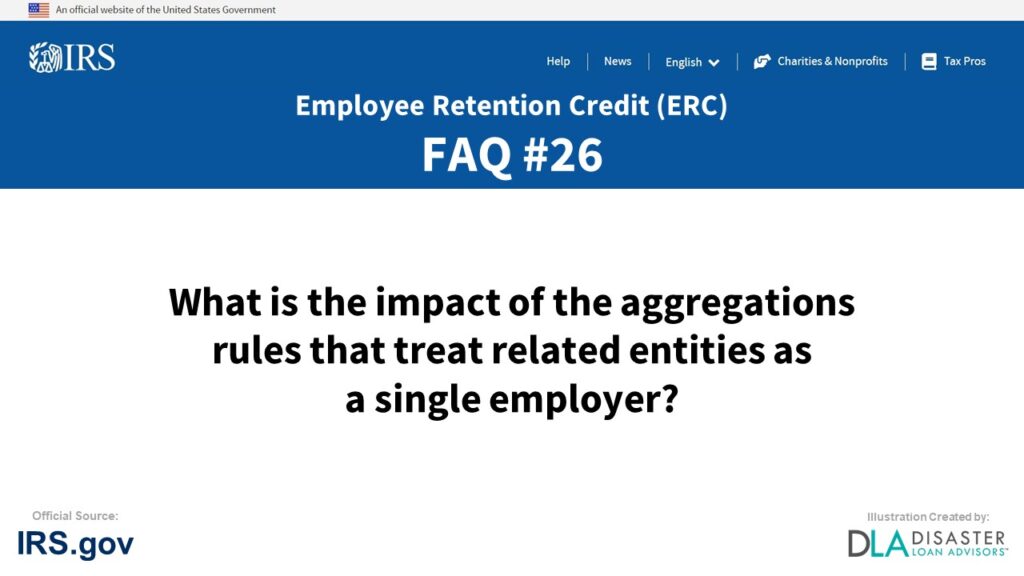
Frequently asked question #26 “What is the impact of the aggregations rules that treat related entities as a single employer?” under the Determining Which Entities are Considered a Single Employer Under the Aggregation Rules section of FAQs: Employee Retention Credit under the CARES Act, provided by the IRS.gov to help business owners understand the ERC program. Information is below for the question #26 What is the impact of the aggregations rules that treat related entities as a single employer?
ERC Credit Frequently Asked Question #26:
COVID-19-Related Employee Retention Credits:
Determining Which Entities are Considered a Single Employer Under the Aggregation Rules FAQs
26. What is the impact of the aggregations rules that treat related entities as a single employer?
All entities that are members of a controlled group of corporations or a group of entities under common control under section 52(a) or (b) of the Internal Revenue Code (the “Code”) rules, members of an affiliated service group under section 414(m) of the Code, or otherwise aggregated under section 414(o) of the Code are considered a single employer for purposes of the application of the Employee Retention Credit rules.
As a result, these employers must be aggregated for purposes of the following rules applicable to the Employee Retention Credit:
- Determining whether the employer has a trade or business operation that was fully or partially suspended due to orders related to COVID-19 from an appropriate governmental authority. For more information, see Determining When an Employer’s Trade or Business Operations are Considered to be Fully or Partially Suspended Due to a Governmental Order.
- Determining whether the employer has a significant decline in gross receipts. For more information, see Determining When an Employer is Considered to have a Significant Decline in Gross Receipts.
- Determining whether the employer has more than 100 full-time employees. For more information, see Does an Eligible Employer identify the average number of full-time employees based on the aggregation rule?
- The application of the rules that preclude an employer from claiming the Employee Retention Credit if any member of the aggregated group received a Paycheck Protection Program (PPP) loan under the Small Business Act. For more information, see Interaction with Other Credit and Relief Provisions.
For more Internal Revenue Service (IRS) Department of the Treasury Employee Retention Credit (ERC) Determining Which Entities are Considered a Single Employer Under the Aggregation Rules FAQs, visit the official IRS.gov tax website.
Conclusion and Summary on ERC Credit FAQ #26. What is the impact of the aggregations rules that treat related entities as a single employer?
The “What is the impact of the aggregations rules that treat related entities as a single employer?” is Frequently Asked Question #26 of many commonly asked questions small business owners are wondering about how to file the Employee Retention Tax Credit (ERTC). The IRS ERC Tax Credit program is a confusing and complex process to determine the correct ERC calculations your business qualifies for. Answers to “What is the impact of the aggregations rules that treat related entities as a single employer?” and filling out form 941-X may change slightly from frequently updated rules and regulations from the IRS. Leave a comment below if you have further questions on ERC Credit FAQ #26.
Help Completing / Filing / Claiming the Employee Retention Credit (ERC)
Receive Up to a $26,000 ERC Credit from the IRS Per Employee
Disaster Loan Advisors can assist your business with the complex and confusing Employee Retention Credit (ERC), Form 941-X, and the Employee Retention Tax Credit (ERTC) program.
Depending on eligibility, business owners and companies can receive up to $26,000 per employee based on the number of W2 employees you had on the payroll in 2020 and 2021.
The ERC / ERTC Tax Credit Program is a valuable IRS tax credit you can claim. This is money you have already paid to the IRS in payroll taxes for your W2 employees.
We DO NOT charge a percentage (%) of your ERC Refund like some companies are charging. Some ERC firms out there are charging upwards of 15% to 35% of your ERC refund!
Our professional ERC fee and pricing structure is very reasonable in comparison.
If you are looking for an ERC Company that believes in providing professional ERC Services and value, in exchange for a fair, reasonable, and ethical fee for the amount of work required, Disaster Loan Advisors is a good fit for you.
Schedule Your Free Employee Retention Credit Consultation to see what amount of employee retention tax credit your company qualifies for.
Cover Image Credit: Irs.gov / ERC FAQ / Disaster Loan Advisors
